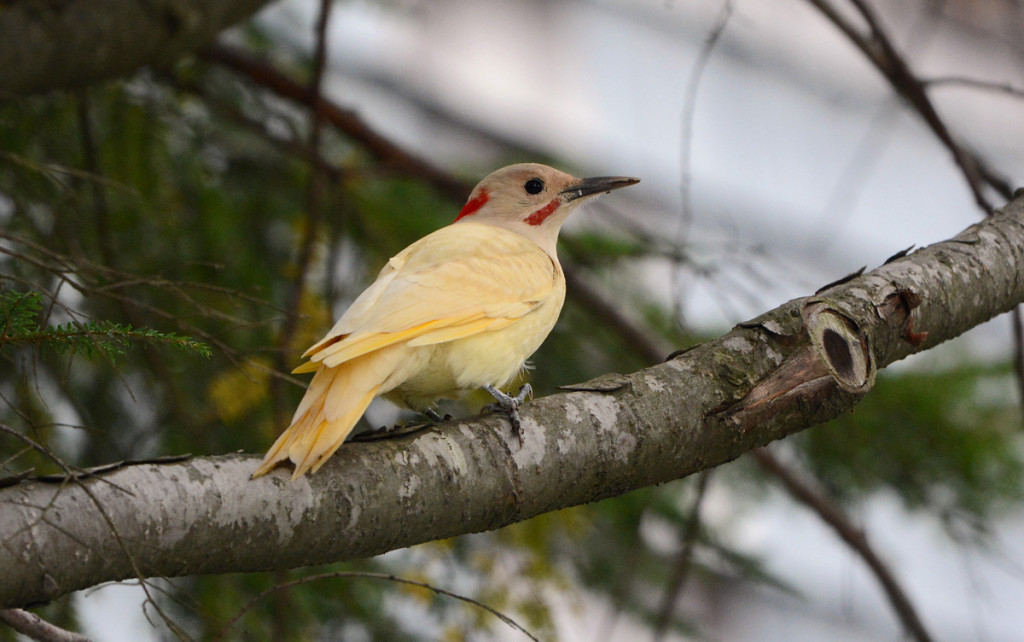
This beautiful and striking bird is a partial albino Northern Flicker, photographed in Massachusetts in Sep 2015 by Michael Beagan.
A second, very similar, bird had been photographed nearby in 2012 by John Harrison, and – besides being very attractive birds – the two provide a good opportunity to discuss some of the details of coloration and abnormal plumage. They are remarkably similar, and there is a fairly simple explanation for their coloration: a reduction in melanin, the same as any other partial albino.
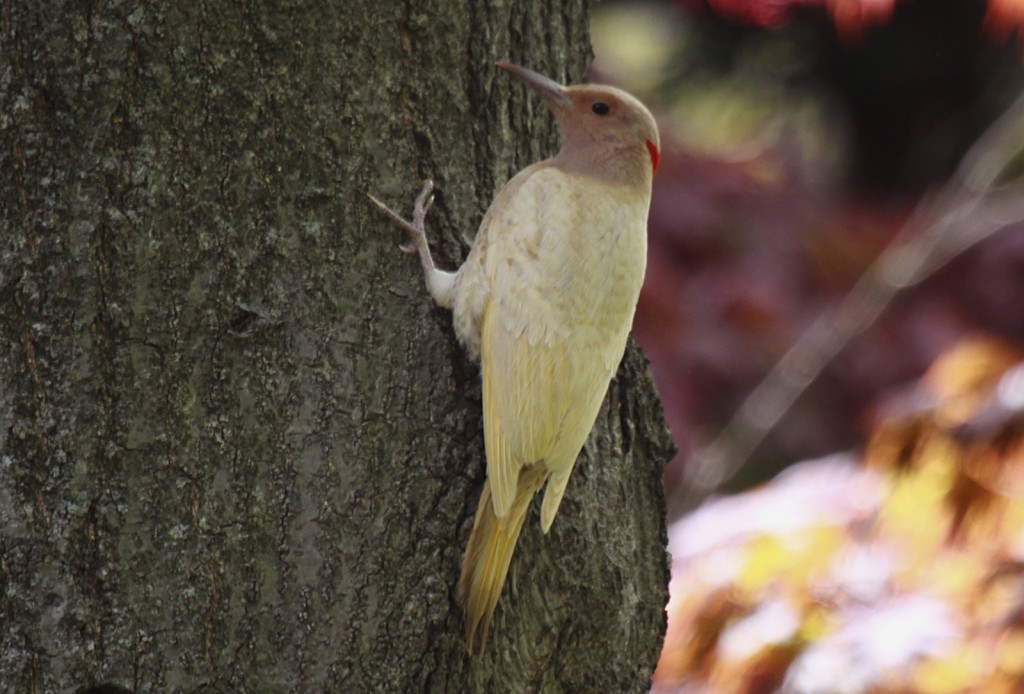
And for comparison – a normal Northern Flicker:
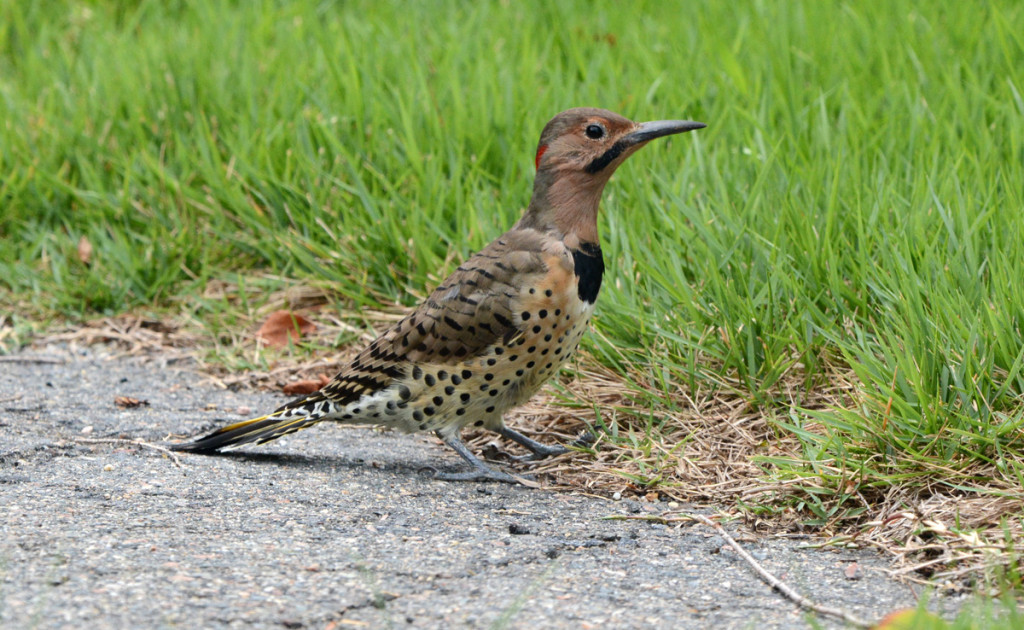
First, to review the basics of color in bird feathers: Almost all colors in bird feathers are produced by two classes of pigments: melanins for black, gray, and brown, and carotenoids for bright yellow to red. Many birds, such as Northern Flicker, combine these two classes of pigments to produce unique and complex patterns of black, brown, yellow, red, etc, but essentially all birds use the same few pigments. Furthermore, there are two types of melanin (a black-gray pigment and a reddish-brown pigment) and either can be affected independently by albinism.
see my post about albinism and melanin in birds
Simplicity is the rule

Suppose you wanted to paint a pattern of black and yellow stripes on a sheet of white paper. If you started at one side and painted yellow stripes and then black stripes in turn across the sheet, that’s complicated and you would risk leaving some thin white gaps showing where the stripes didn’t quite meet. To avoid that you could paint the yellow stripes a little wider than they needed to be, so that the black stripes would cover all of the remaining white (and some of the yellow). But why bother with all that extra work with the yellow stripes? Just paint the entire sheet yellow, then paint black stripes over that.
That’s not a perfect analogy, because a bird can only deposit color once as each feather grows, more like a printer coloring a sheet of paper as it passes through the ink jets. But the point remains – it is far simpler to just turn on the yellow pigment and leave it on to color the entire feather yellow, with intermittent bursts of black to form a barred pattern as the feather grows.
So what’s going on here?
It is clear that both of these flickers are missing most of the melanin from their feathers. To be more precise, it is likely that they are missing the gray-black pigment eumelanin, which creates the black bars and spots along with much of the dark dusky color of the back. The absence of eumelanin reveals the rust- or buff-colored phaeomelanin, mainly in the pinkish-brown color on the head.
The lack of melanin also reveals the yellow (carotenoid) pigments that exist throughout the wings and tail.
The “mustache” mark on these birds deserves some discussion. This marking is present only on males, and on male Yellow-shafted Northern Flickers (of Canada and the eastern US) it is black. Since these two albino birds are lacking the melanin needed to produce a black stripe, we might conclude that the absence of a mark there (as on the 2012 bird) is expected and we cannot determine the sex of that bird. But the 2015 bird shows a bold red stripe there, like a Red-shafted Northern Flicker from the western US. It’s clearly not a vagrant from the west, as it shows yellow wings and tail, and a red crescent on the nape, all characteristic of the expected Yellow-shafted subspecies. The explanation is that all male Yellow-shafted Flickers have both red and black pigments in the mustache mark. Normally the black color masks the red, but in this case the black pigment is missing while the red is undiminished, producing a bright red mustache. It follows then that the 2012 bird, lacking any trace of a mustache, must be a female.
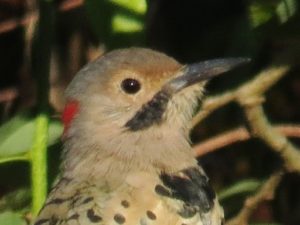
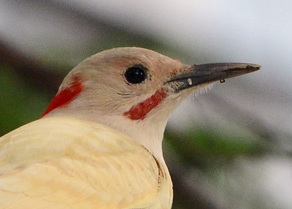
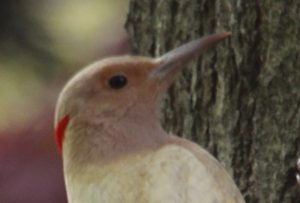

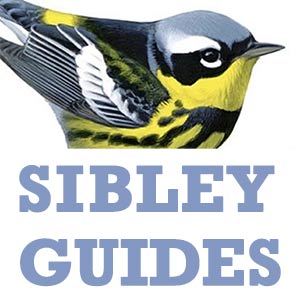
David: Our collection at the Cleveland Museum of Natural History has a similar specimen which lacks melanin and still shows carotenoids. There is no buff coloration on the face, so maybe the bird here lacks both eumelanin and phaeomelanin? Interestingly, the lack of melanin also unmasks some red tips on the crown feathers.
I posted some images on Twitter a few months ago:
Andy Jones, Cleveland
we spotted a white northern flicker in our back yard Ottawa Ontario
Pingback: Blog Birding #247 « ABA Blog
I have commented on the Needham Mass bird already and think more likely that this abnormal colored flicker exhibits xanthochromism as well as a reduction of melanin as seen in more typical leucistic birds. I think that leucism alone does not account for the hyper-yellow pigmentation in the bird.
Andy Engilis — Curator UC Davis Museum of Wildlife
How do we know that “all male Yellow-shafted Flickers have both red and black pigments in the mustache mark?” Could you provide a reference for this? Isn’t it possible that the 2015 bird could be an intergrade? If a bird from the northern limits of the contact zone migrated with “pure” YSFL birds eastward, it seems conceivable that an intergrade could end up in Mass.
Further, regarding Andy E’s comment above, wouldn’t a flicker that expresses yellow in places where it “shouldn’t” be considered xanthochroic? In my admittedly limited knowledge of genetics, could it also be possible that a leucistic + xanthochroic flicker could express too much carotenoid in the mustache, leading to a red mustache in a bird that should have none there?
Fascinated by the whole issue!
Thanks for an interesting article on NOFL coloration!
Folks at Manomet Bird Observatory have been catching “Flicker Intergrades” (presumed YSFL x RSFL with a few red-shafted feathers and occasional incursion of red in the dark malar) for years, but we are currently working on a paper in collaboration with the Royal Alberta museum and National Aviary that debunks this theory and attributes these false intergrades to ingestion of rhodoxanthin (non-carotenoid, red coloration) via invasive Honeysuckle berries during migrant Flickers’ fall, complete pre-basic molt. Here’s a link to a newsletter article on the subject:
https://www.manomet.org/newsletter/what%E2%80%99s-red-yellow-and-manomet-bander%E2%80%99s-delight
Keep up the interesting topics!
Evan Dalton
Lead Instructor, Landbird Conservation
Manomet
We live about two blocks from the photographer and have seen this amazing bird as well. I suppose is is likely to be the same individual as in the photo. A normally colored flicker is often in the yard with it. We saw it first during the summer of 2015 and then again in April 2016. It is a sight to behold. Beautiful.
“Partial albino” ?